(I am not sure whether this should be in Lovely Grub or Out and About so Mods please decide)
Went to visit a longhouse to wish them a Happy Gawai (Harvest festival). I went before the actual festivities so stayed on to get in the way of some of the preparation.
When I arrived they were down the river bank cooking rice in Bamboo.

[Rice cooking]
Now you would think that this is straightforward but, as usual, there are subtleties that escape casual observation and which are not mentioned in Lofty Wiseman’s SAS Survival Guide (as far as I can recall). I have used both the water and rice in the same bamboo section method and the water in the lower section and rice/food in upper section method with mixed results – the food is usually cooked but the rice is either underdone or burnt.
This is representative of my usual efforts
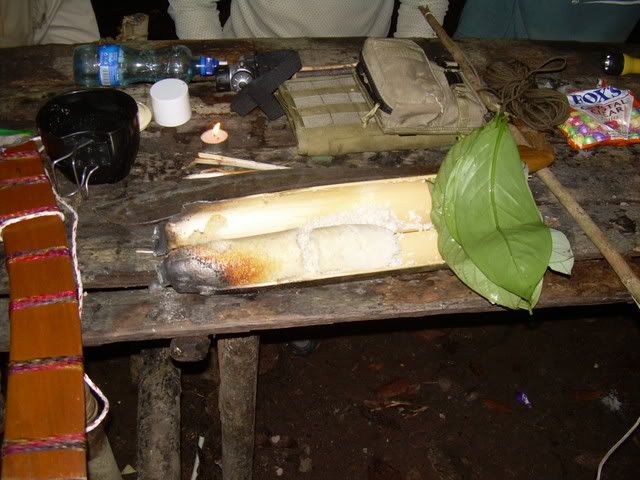
This old lady kindly showed me how. (Tip: start with the older women and men if you want to learn anything. If you talk to the young men they just want to practice their English and learn about the West from you)
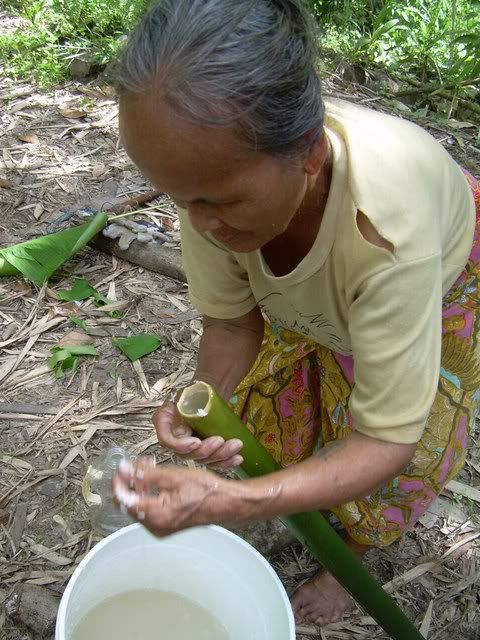 Loading Rice tubes
Loading Rice tubes
Mix rice and water in a container. Fill bamboo to about ½ to 2/3rd with water. Gently scoop up rice and water and let it slide down the bamboo. Do not tamp or compress the rice. Push gently with a finger if it is stuck or roll the tube between your hands till it slides down. Do not knock the bottom of the tube on the ground to make the rice drop down. Fill the tube till you can feel the rice reach about a fingers length from the rim. Bamboo must be full of water to the rim. Plug with wild banana or other suitable leaves. Place over fire.
Then duck down to the river, to do what foreigners do, to sneak a peek at a native woman bathing

The reason not to compress the rice is that it is a very effective plug as it is sticky and the pressure can build up dramatically. One of two things happen. A rice round is fired from the mortar or the tube blows up or splits with the possible risk of bamboo splinter shrapnel if you are close by.
Elsewhere these cow hooves were being roasted prior to being made into a stew. The hooves are being removed. Nothing but the actual hard part of the hoof is being discarded.

While waiting for dinner, I found the band tuning their gongs.
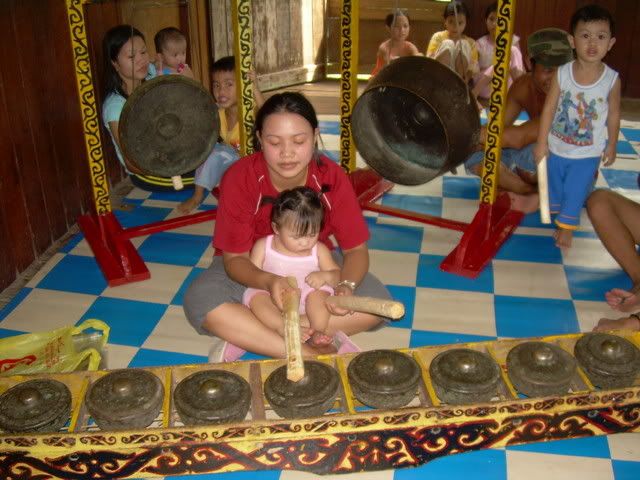
Children are part of everything and stay up late as the festivities progress. The kids are absolutely great. Always well mannered, playful and caring of each other they are not repressed and seldom scolded let alone smacked. A psychologist counsellor friend on a trip into the interior noted that we did not once hear a crying child. That is not always the case though and this little chap didn’t look happy at the sight of me (and who could blame him!!)
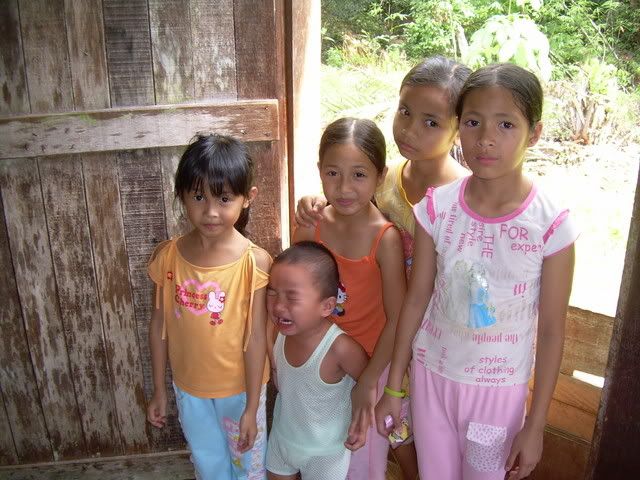
We later sat down to a meal. This is how bamboo rice should look like.

The courses included
Chicken guts and unlaid eggs (Subtle flavours, not bad and not chewy)

Hoof stew (gelatinous and a tasty broth) No pics.
Beef tendons and veins (yummy and delicious - would appeal to those who like roasts or bacon)

Fermented fish (reminiscent of blue cheese or Stilton)
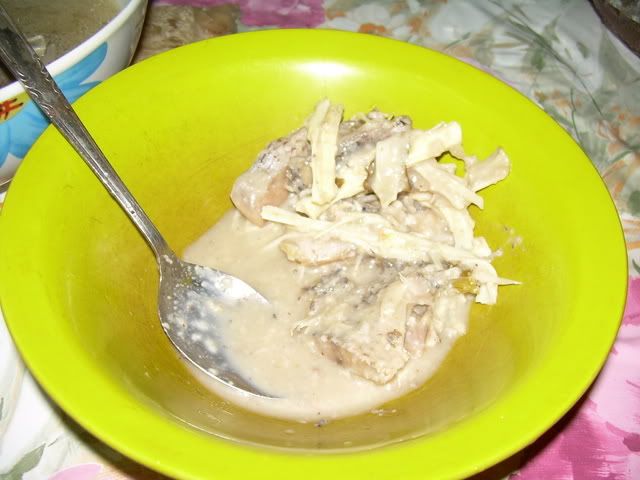
After dinner the ladies left and the gentlemen passed the tuak (rice wine) around (and around and around) till we couldn’t remember what we, or anyone else, were saying
Like New Year, Gawai is celebrated by waiting till midnight on 1 June when a midnight feast is served. Now I usually face meals of monkey head, ant egg soup, snake, pig lungs, mouse deer and the like (shown elsewhere on this site) and tonight’s earlier dinner was no exception. I also face the problem of what presents to bring and it is often a dilemma as I refuse to bring cigarettes, lollies, sweet cakes or any kind of modern junk food.
This time I had a solution. I brought Australian rack of lamb (which I proudly announced as “kambing Australia” – Australian goat - ) and duck so Gawai was ushered in with these exotic additions. They indulged me and were too polite to say what they thought of the roast lamb and duck but I do think they enjoyed the novelty. These modern Dayak girls visiting their granny seemed to like it.

After the dinner the tuak was passed around again. I retired about 2.30 in the morning
The festivities continued till dawn
The next morning saw many casualties on the ruai (verandah) and unusually I woke up before most of the younger men. I had long chats with the older men about harvests, parang blade design and British helicopter pilots who land mistakenly in padi fields thinking it is an LP (and, now that this service has been privatized, whose company does not pay compensation).
Later on returning family members started to arrive and a bedara ceremony was held and I was roped in as a celebrant. I have done these before; at a new longhouse naming ceremony (rare nowadays - with Japanese heads or at least that’s what they said) and at weddings but this was my first bedara at a Harvest Festival.
Basically, it is about appeasing spirits (human and, possibly, supernatural others). The celebrants prepare plates of food and necessities for the spirits and these are placed near the roof or rafters (where the heads used to be kept). There is also a sacrifice of a chicken and the family members are anointed with blood which as had feathers dipped in it.
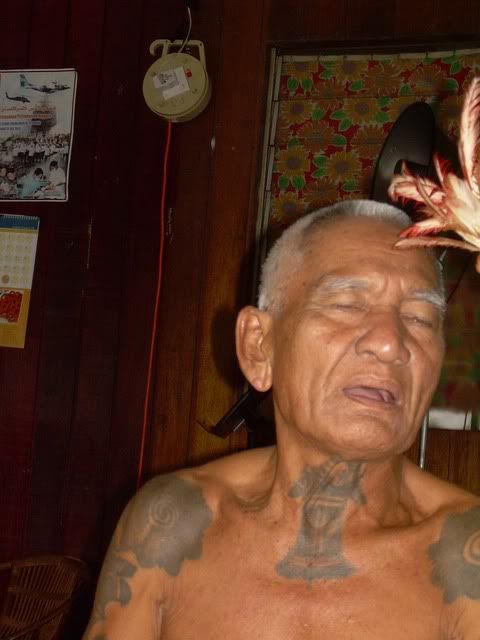
This is repeated for every bilek or household in the longhouse and it is tiring work. Each celebrant prepares a dish with the ingredients in 5s, 7s, 8s or 9s. These ingredients are pinang nut (betel) sections, betel leaves (torn into ports), a paste, serdeh leaves, cooked rice (try dividing a handful or rice into 7 sections!), pulut (sticky rice – no problem), little rice bundles in leaves, cakes in leaves, a kind of cookie. Tobacco, leaves for rolling cigarettes, salt, puffed rice(like pop corn), egg sections surmounted with a whole egg and sprinkled with tuak. Basically everything for a spirit’s spiritual needs - staples, salt, protein, fertility, cakes, narcotics and some fags (cigarettes to American members). This is where you get the ingredients
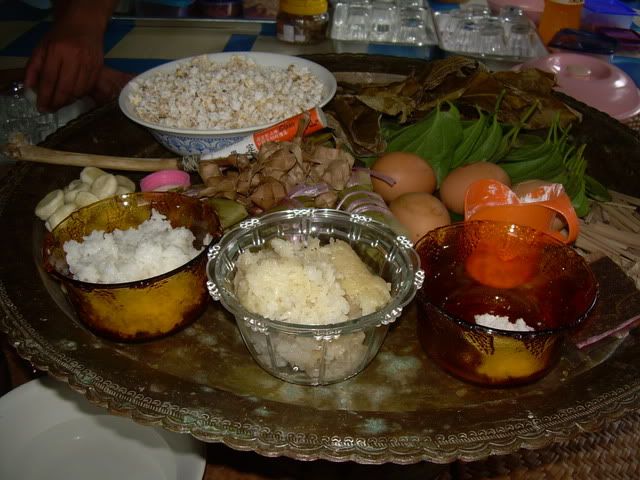
This is completed plate. I wasn’t being messy. Some puffed rice is spread around for those spirits that can’t wait.
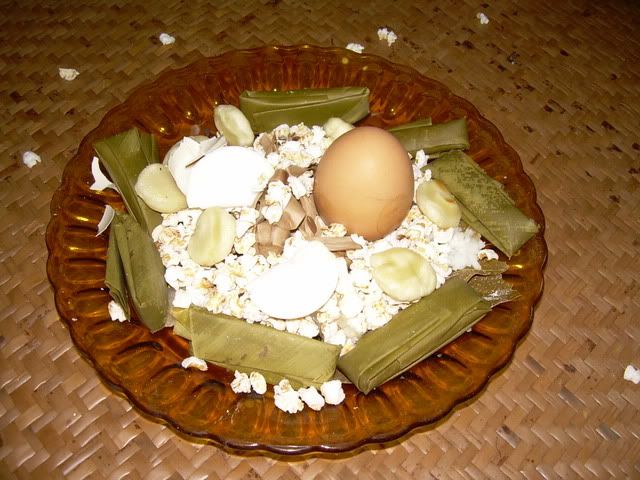
We cut some items like the eggs with these knives. The handle is monkey femur. The monkey was blow piped down from the tree apparently according to the blacksmith.
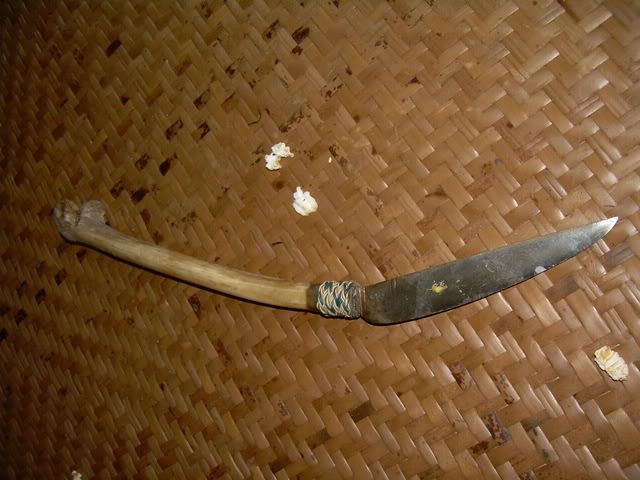
An interesting difference in the ceremony was the “altar wine”. A bowl of tuak is brought around by a celebrant and you sip it just like at communion. But a rod with brass bells and sea shells is dipped in it and jiggled as you drink and your face gets splashed which is why my eyes are shut. Everyone laughs. The whole ceremony a few hours so a sense of humour is necessary. It is all taken in good fun.
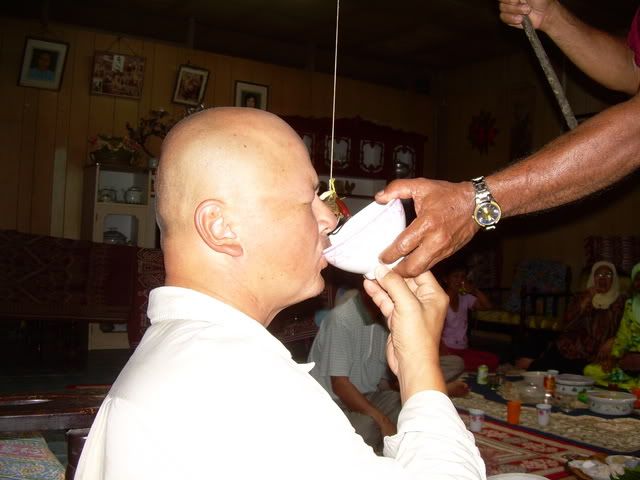
Went to visit a longhouse to wish them a Happy Gawai (Harvest festival). I went before the actual festivities so stayed on to get in the way of some of the preparation.
When I arrived they were down the river bank cooking rice in Bamboo.

[Rice cooking]
Now you would think that this is straightforward but, as usual, there are subtleties that escape casual observation and which are not mentioned in Lofty Wiseman’s SAS Survival Guide (as far as I can recall). I have used both the water and rice in the same bamboo section method and the water in the lower section and rice/food in upper section method with mixed results – the food is usually cooked but the rice is either underdone or burnt.
This is representative of my usual efforts

This old lady kindly showed me how. (Tip: start with the older women and men if you want to learn anything. If you talk to the young men they just want to practice their English and learn about the West from you)

Mix rice and water in a container. Fill bamboo to about ½ to 2/3rd with water. Gently scoop up rice and water and let it slide down the bamboo. Do not tamp or compress the rice. Push gently with a finger if it is stuck or roll the tube between your hands till it slides down. Do not knock the bottom of the tube on the ground to make the rice drop down. Fill the tube till you can feel the rice reach about a fingers length from the rim. Bamboo must be full of water to the rim. Plug with wild banana or other suitable leaves. Place over fire.
Then duck down to the river, to do what foreigners do, to sneak a peek at a native woman bathing

The reason not to compress the rice is that it is a very effective plug as it is sticky and the pressure can build up dramatically. One of two things happen. A rice round is fired from the mortar or the tube blows up or splits with the possible risk of bamboo splinter shrapnel if you are close by.
Elsewhere these cow hooves were being roasted prior to being made into a stew. The hooves are being removed. Nothing but the actual hard part of the hoof is being discarded.

While waiting for dinner, I found the band tuning their gongs.

Children are part of everything and stay up late as the festivities progress. The kids are absolutely great. Always well mannered, playful and caring of each other they are not repressed and seldom scolded let alone smacked. A psychologist counsellor friend on a trip into the interior noted that we did not once hear a crying child. That is not always the case though and this little chap didn’t look happy at the sight of me (and who could blame him!!)

We later sat down to a meal. This is how bamboo rice should look like.

The courses included
Chicken guts and unlaid eggs (Subtle flavours, not bad and not chewy)

Hoof stew (gelatinous and a tasty broth) No pics.
Beef tendons and veins (yummy and delicious - would appeal to those who like roasts or bacon)

Fermented fish (reminiscent of blue cheese or Stilton)

After dinner the ladies left and the gentlemen passed the tuak (rice wine) around (and around and around) till we couldn’t remember what we, or anyone else, were saying
Like New Year, Gawai is celebrated by waiting till midnight on 1 June when a midnight feast is served. Now I usually face meals of monkey head, ant egg soup, snake, pig lungs, mouse deer and the like (shown elsewhere on this site) and tonight’s earlier dinner was no exception. I also face the problem of what presents to bring and it is often a dilemma as I refuse to bring cigarettes, lollies, sweet cakes or any kind of modern junk food.
This time I had a solution. I brought Australian rack of lamb (which I proudly announced as “kambing Australia” – Australian goat - ) and duck so Gawai was ushered in with these exotic additions. They indulged me and were too polite to say what they thought of the roast lamb and duck but I do think they enjoyed the novelty. These modern Dayak girls visiting their granny seemed to like it.

After the dinner the tuak was passed around again. I retired about 2.30 in the morning
The festivities continued till dawn
The next morning saw many casualties on the ruai (verandah) and unusually I woke up before most of the younger men. I had long chats with the older men about harvests, parang blade design and British helicopter pilots who land mistakenly in padi fields thinking it is an LP (and, now that this service has been privatized, whose company does not pay compensation).
Later on returning family members started to arrive and a bedara ceremony was held and I was roped in as a celebrant. I have done these before; at a new longhouse naming ceremony (rare nowadays - with Japanese heads or at least that’s what they said) and at weddings but this was my first bedara at a Harvest Festival.
Basically, it is about appeasing spirits (human and, possibly, supernatural others). The celebrants prepare plates of food and necessities for the spirits and these are placed near the roof or rafters (where the heads used to be kept). There is also a sacrifice of a chicken and the family members are anointed with blood which as had feathers dipped in it.

This is repeated for every bilek or household in the longhouse and it is tiring work. Each celebrant prepares a dish with the ingredients in 5s, 7s, 8s or 9s. These ingredients are pinang nut (betel) sections, betel leaves (torn into ports), a paste, serdeh leaves, cooked rice (try dividing a handful or rice into 7 sections!), pulut (sticky rice – no problem), little rice bundles in leaves, cakes in leaves, a kind of cookie. Tobacco, leaves for rolling cigarettes, salt, puffed rice(like pop corn), egg sections surmounted with a whole egg and sprinkled with tuak. Basically everything for a spirit’s spiritual needs - staples, salt, protein, fertility, cakes, narcotics and some fags (cigarettes to American members). This is where you get the ingredients

This is completed plate. I wasn’t being messy. Some puffed rice is spread around for those spirits that can’t wait.

We cut some items like the eggs with these knives. The handle is monkey femur. The monkey was blow piped down from the tree apparently according to the blacksmith.

An interesting difference in the ceremony was the “altar wine”. A bowl of tuak is brought around by a celebrant and you sip it just like at communion. But a rod with brass bells and sea shells is dipped in it and jiggled as you drink and your face gets splashed which is why my eyes are shut. Everyone laughs. The whole ceremony a few hours so a sense of humour is necessary. It is all taken in good fun.

